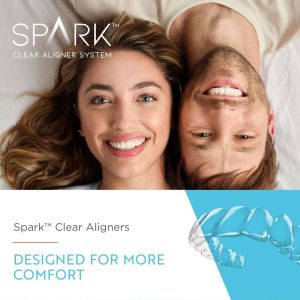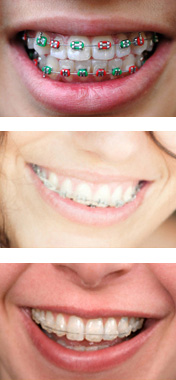Orthodontics is the specialty dealing with the straightening of teeth position, regulation of the occlusion (bite) and the relation between the 2 maxillaries. The word origins in the old greek and it is formed from “ortho” – right and “dons” – tooth.
Beautiful and straight teeth make a person more attractive, more self – confident. Agglomerated teeth or those with spaces between them are not just an esthetic issue; in time, dental caries (hygiene cannot be carried out accordingly), parodonthopaties (affectation of the periodontium – of the tissue supporting the tooth in the bone), mastication and articular issues can appear.

Advantages of the orthodontic treatment:
- aesthetics – maybe it should not be placed first, but it is the main reason why the patient addresses to the orthodontist; aligned teeth are a major change in our smile, physiognomy and self-confidence;
- functionality – mastication and, in many cases, phonation (speaking) are improving;
- the duration the teeth are maintained on the arch is increased;
- correctly aligned teeth and those which correctly meet their neighbours and antagonists (teeth on the other maxillary) are easier to sanitise and will last longer on the arch;
- teeth were “built” to be constantly and continuously used during out life; an incorrect position of a tooth implies a wrong functionality, with a reduction of its life on the arch.
Even if the orthodontic treatment can last 1 – 2 years, it has important benefits for life.
Stages of an orthodontic treatment:
- first consultation – first stem in the doctor – patient relation; the doctor performs a first evaluation of the patient and the latter expresses his/her desires and expectations. The impression for the study models is made.
- treatment plan draw up: the doctor performs a thorough analysis of the diagnostic models, radiographies and pictures, analysis based on which a complete diagnostic and a treatment plan are drawn up;
- secondary consultation: actually, a discussion with the patient, presenting the treatment plan and the existing options;
- application of the fixed or mobile braces; indications are given for hygiene and food;
- monthly controls and braces activation – usually once every 4 weeks for a period of 1 – 3 years, depending on the case complexity;
- end of treatment – following the end of treatment is a period for stabilising the obtained result (contention period). Performed with a fixed retainer, a transparent tray or a contention plate, depending on each case.
Aligners Treatment
 Choosing an orthodontic treatment and the type of appliance is an important decision that must be taken together with the dentist following a thorough evaluation of the respective case.
Choosing an orthodontic treatment and the type of appliance is an important decision that must be taken together with the dentist following a thorough evaluation of the respective case.
Each patient is unique, has different needs and expectations, so the treatment plan must be personalized.
Orthodontic treatment with alignment is a modern treatment, carried out 100% digitally and involves straightening the teeth with the help of thin and transparent braces.
How does an aligner work?
The orthodontist designs the entire orthodontic treatment step by step in a software. The result is a sequence of transparent trays that change periodically (generally every 7 days), with the help of which the teeth move gradually and controlled to a correct position.
What are the advantages of treatment with aligners??
- Aesthetics – being made of a transparent material, the device is almost invisible
- Comfort-guts are thin, elastic and cannot inflame the gums
- Speech is easy – throats do not change speech
- Hygiene and nutrition – being a removable device, oral hygiene and mastication can be achieved in optimal conditions
- Fast – for most patients and if the appliance is worn correctly, this treatment can be faster than the one carried out with the help of brackets
- Correct bite – because the orthodontist can design and then control the position of each individual tooth, the treatment is efficient and predictable
What else do you need to know about this treatment?
– for maximum effectiveness, the aligner must be worn 22 hours a day, must be inserted correctly and must be removed at meals and when brushing your teeth
– unlike the treatment with a fixed orthodontic appliance, this therapy depends to a greater extent on the good cooperation of the patient, who must assume the correct insertion and wearing of the mouthpiece 22 hours a day. Otherwise, the following mouthpieces will not be they will fit better and the treatment plan must be redone
– depending on the complexity of the case, a treatment can last from just a few months to 2 years
-visits to the orthodontist are rare (about every 2-3 months)
– a slight tension is felt at the level of the teeth, but this is of low intensity.
Fixed orthodontic apparatus
Bracket
Is a prefabricated element with a size and design specially made for each and every tooth. It is fixed on the tooth surface with a special adhesive that does not affect the enamel. The brackets are connected between them through a metallic string that is changed at a certain period of time. This string (spring) exercises a slight and continuous pressure on the teeth which causes the dental movement. After each activation (usually monthly) can appear a slight pain sensation but which disappears after 2-3 days.

Autoligating bracket
The spring is fixed with a system embedded in the bracket, which makes the teeth movement and derotation faster and with reduced sensitivity. The treatment duration is shortened and the patient comfort is increased.
Metallic bracket
Is resistant and less expensive; the spring can be fixed with elastic modules of different colours in order to give the smile personality.
Clear bracket
It is especially recommended for adults whose aesthetics is a main requirement. It is made of ceramics or synthetic sapphire, white or transparent, less visible than the metallic bracket. It is less resistant, more expensive and the friction between it and the string can extend the treatment duration.

